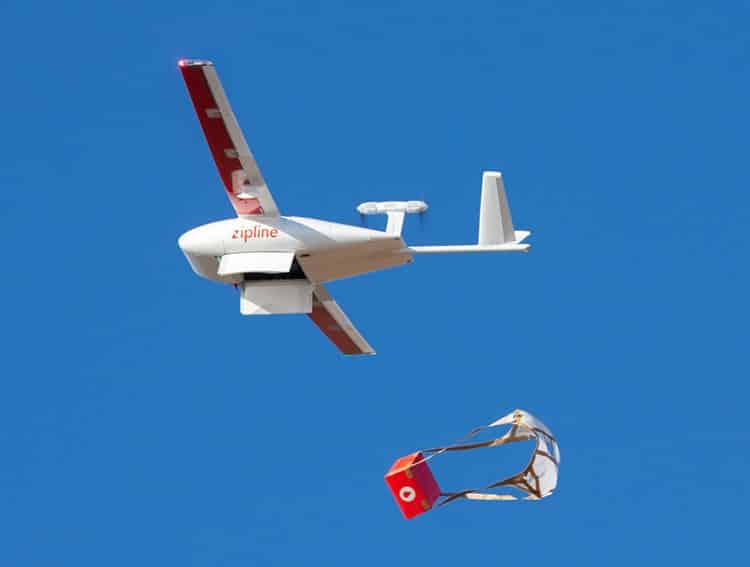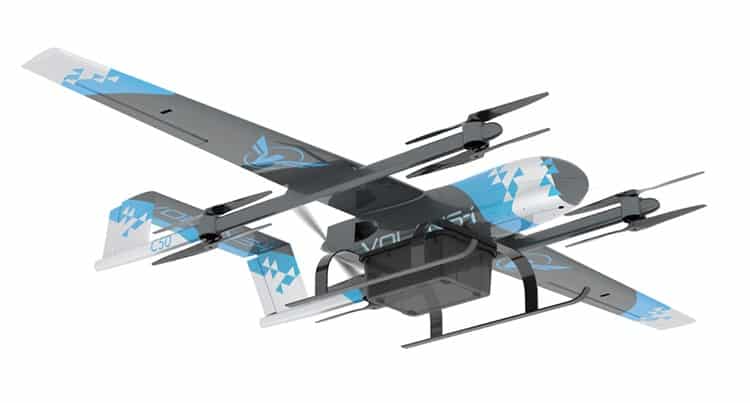Can Flying Delivery Drones Deliver the Goods?
Table of contents
Table of contents
- Last-Mile Transportation and Delivery
- Can Flying Drones Deliver Cost Savings?
- Big Tech and Retail Companies Launching Delivery Drones
- Startups Developing Flying Delivery Drones
- Most Well-Funded Delivery Drone Startup
- Flying Delivery Drones for Cargo
- Flying Delivery Drones on the Cheap
- A Publicly Traded Drone Company?
- Conclusion

One of the challenges involved in writing about emerging technologies for investment opportunities is that, well, you’re waiting for the technology to emerge at a stage where it is viable, scalable, and profitable. In the case of flying delivery drones, the issue is compounded by regulatory issues in the United States of operating aircraft – no matter how small or cute – over populated areas riddled with obstacles. However, it appears that this is the year that we may finally see flying delivery drones delivering the goods, as the Federal Aviation Administration (FAA) approved the first commercial service earlier this year (more on that below).
Last-Mile Transportation and Delivery
Flying delivery drones are part of what’s become known as the last-mile transportation solution that’s propelled bicycle and scooter startups to billion-dollar valuations. The idea is that we can reduce both carbon emissions and city congestion caused by trucks and cars choking the roads by taking short trips on alternative modes of transportation. In the same vein, autonomous drones could be the answer for transporting everything from pizza to a pig pancreas right to your front door. Last year, researchers calculated the actual savings in emissions that could result from drone delivery, estimating a 54% reduction in greenhouse gas emissions in states like California.

Of course, there are plenty of assumptions built into the numbers from the study, which noted that the best-case scenario would minimize building new warehouses for drone hubs while limiting the size of the flying robots.
Can Flying Drones Deliver Cost Savings?
While there seems to be a cost benefit in terms of the environment, we also want to know whether flying drone delivery makes sense economically. The answer, of course, depends on who you ask. For instance, a firm called Skylark Drone Research put out a report a couple of years ago that gave an unequivocal “yes” to the question. While we are leery of such industry-backed reports, the co-authors seem to be legitimate PhDs with backgrounds in economics. And there are lots of charts with numbers to delight the dullest MBA. The mid-range forecast from the study forecasts as many as 50 million daily deliveries by drones within 20 years, accounting for a savings of $10 billion.

Again, a lot of assumptions prop up those numbers, though the authors do take into consideration everything from weather conditions to public policy in their analysis. The red numbers in the chart above represent costs below the $2.50 baseline for ground transportation that companies like Amazon now pay to deliver a package. We can also imagine other indirect savings, such as less wear and tear on roads and bridges, though no doubt some of those costs would be offset by the need for local governments to invest in more air safety infrastructure and new kinds of air traffic management software.
Big Tech and Retail Companies Launching Delivery Drones
While we could ride this cost-benefit roller coaster all day long, a simpler measure may be just to look at all of the big tech and retail companies that are investing millions of dollars into flying delivery drones. You generally don’t spend that kind of money on R&D for novelty’s sake.
Everyone probably assumes Amazon (AMZN) is the company to beat in the commercialization of flying delivery drones, but it’s actually Google (GOOGLE) that is flying higher. That FAA certification we mentioned in the introduction went to Wing, a company spun out of Google’s shadowy R&D division known as X Development. Wing has been testing its drone delivery service for a few years already in Australia and Finland. The concept is pretty simple: Customers order items through an app from participating merchants, the drone then lifts off and returns to the same site after delivering its cargo while not making a single sound. The drone is designed with both fixed wings and hover propellers, and is capable of carrying a little more than three pounds at a time, with a range of 12 miles and max speed of 70 miles per hour.
Of course, we’re not suggesting that Amazon is out of the fight by any means. Just this month, the e-commerce giant unveiled its latest Amazon Prime Air drone, which is also a copter/plane hybrid that uses artificial intelligence to navigate, according to an article in Fortune. The FAA granted the company a one-year approval for test flights, so Amazon is still at least another 12 months away from commercial operation, Fortune reported. And we haven’t even talked about UberExpress, a drone delivery operation within the ride-hailing company’s Uber Eats food delivery unit. It reportedly has plans to begin flying delivery drone service by 2021. There’s also plenty of delivery drone activity overseas. One of the bigger players, Chinese e-commerce giant JD.com, is testing the service in Indonesia, as part of a larger push into all of Southeast Asia.
Startups Developing Flying Delivery Drones
Meanwhile, a whole squadron of startups are also working on developing their own flying delivery drones. We’ve covered most of the major ones, including Zipline, Flirtey, and Matternet, as well as Flytrex and Drone Base.
Matternet has been making some decent progress. After 1,800 flights over Swiss cities with a perfect safety track record and 850 on-demand deliveries of patient’s blood and pathology specimens, the company has now partnered with UPS to establish “the first FAA sanctioned use of a drone system for routine revenue flights in the US,” which is also taking place in the poverty-stricken slums of North Carolina.
Let’s look at some more drone delivery companies that are soaring to new heights.
Most Well-Funded Delivery Drone Startup


The company recently announced it would begin pilot programs closer to home, beginning with the Third World country known as North Carolina.
Now let’s check out a few delivery drone startups that we haven’t covered yet.
Update 06/30/2021: Zipline has raised $250 million in new funding at a post-money valuation of $2.75 billion to fuel further expansion of its logistics networks in Africa and the United States. This brings the company’s total funding to $483 million to date.
Flying Delivery Drones for Cargo


Volans-i serves both the commercial and defense sectors, specializing in the delivery of supplies and equipment for industries as diverse as mining and healthcare.
Update 09/15/2020: Volansi has raised $50 million in Series B funding to expand into new territories globally. This brings the company’s total funding to $75.1 million to date.
Founded in 2016, Elroy Air is another San Francisco-based flying delivery drone startup that is developing technology for hauling cargo more on the scale of Volans-i rather than Amazon packages. It has raised $9.2 million to date, about half of which came in a second Seed round in February. Its giant hybrid drone is called the Chaparral, which is capable of carrying up to 500 pounds of cargo for 300 miles. Supplies are carried via a separate pod, which the company says improves the efficiency of loading and unloading cargo.
Update 08/05/2021: Elroy Air has raised $40 million in Series A funding to ramp up the building, testing and validation of its inaugural autonomous cargo drone. This brings the company’s total funding to $56 million to date.
Flying Delivery Drones on the Cheap

Founded in 2018, Arone is a Nigerian startup that got $100,000 from Angel investors to develop flying delivery drones for medical supplies. The company says its drones uses computer vision and artificial intelligence for “flight planning, obstacle manoeuver and parcel recipient detection.” The system relies on solar-powered recharging stations placed about 120 miles apart for swapping and recharging batteries. Seems like the use of flying drones to deliver medical stuff is a promising application.
A Publicly Traded Drone Company?
Finally, we bring you Workhorse Group (WKHS), a company that trades on the NASDAQ capital market, which is a good thing, because the company definitely needs capital based on its revenues versus expenditures, which you can read more about here and here before you make any rash investment decisions. (It did just raise $25 million in new capital to keep the lights on.) Its core product is an all-electric delivery truck, but it is developing a six-rotor flying delivery drone, the Horsefly, that works in tandem with the truck. The truck features a control center for the driver and the roof serves as both landing pad and charging station. Packages are delivered via a winch system, much like the drones from Wing.

Big news came last month when General Motors was looking to sell their Lordstown vehicle factory in Ohio to Workhorse which is said to be in “roughly preliminary discussions.” The company is ambitious, if nothing else, as Workhorse is also developing its own flying car that it calls SureFly. Maybe focus on getting the truck done first so investors can see some positive cash flows?
Conclusion
In the age of on-demand everything, it seems like we’ve been waiting a lifetime for flying delivery drone service to take off. It appears the time has finally arrived, with the FAA finally approving the first commercial service. While the government has been viewed largely as an impediment, it did initiate the Unmanned Aircraft Systems Integration Pilot Program a couple of years ago to accelerate the integration of drones into U.S. airspace and the economy. It’s also interesting to see how the category is expanding to include larger cargo capacity under startups like Volans-i and Elroy Air, whose airframes are not dissimilar to some of the hybrid electric airplanes that are being developed. Quite a few startups are targeting medical applications, including slurpee delivery startup Flirtey which now wants to deliver defibrillators. The only thing standing in the way now, it would seem, are the anti-drone technology Luddites.
Sign up to our newsletter to get more of our great research delivered straight to your inbox!
Nanalyze Weekly includes useful insights written by our team of underpaid MBAs, research on new disruptive technology stocks flying under the radar, and summaries of our recent research. Always 100% free.














